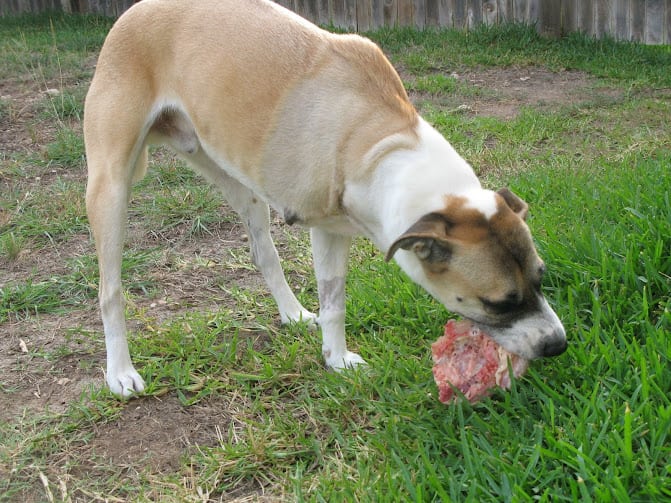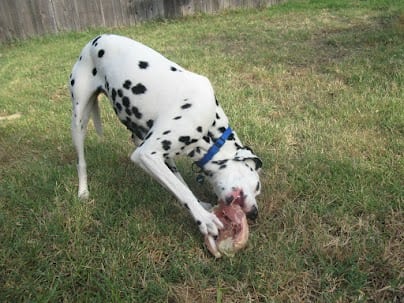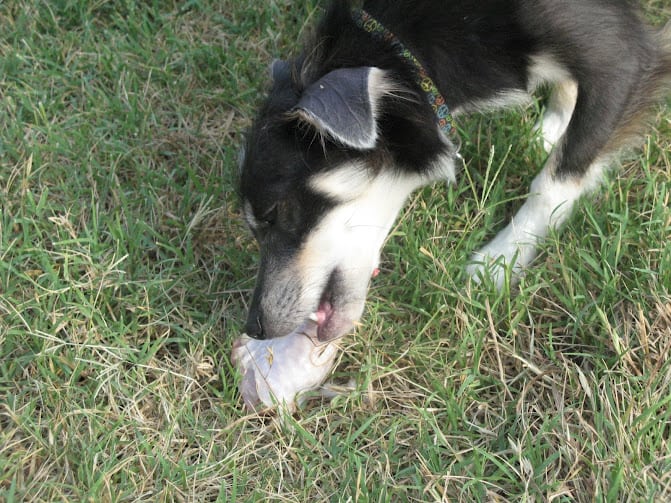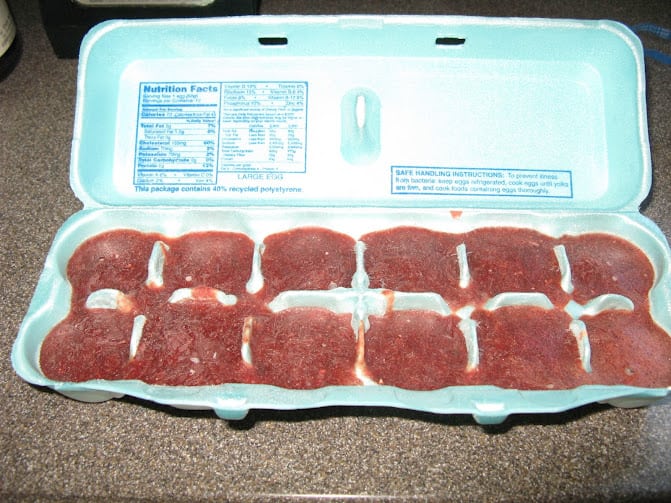Lots of buzz is circulating about raw food for dogs, but do you know the facts about raw feeding? Here’s a great place to begin, thanks to Tripawds member Jack and his momma Jill, who contributed the following article about raw feeding facts based on their own primal diet.
 As a researcher at the University of Texas with a master’s degree in endocrinology, Jill has a great interest in raw feeding.
As a researcher at the University of Texas with a master’s degree in endocrinology, Jill has a great interest in raw feeding.
Here is a great article about raw feeding that was written by Jill, just for the Tripawds community.
Why Feed Raw?
Unfortunately the dog food industry is not regulated like food is for human consumption; all you have to do is look at the dog food recalls and the issues we have with contamination (and sadly, sick dogs and occasional fatalities) to realize this. We have to trust that a company is making ethical decisions when they make dog food and hope that we don’t become victims of a contamination or toxic ingredient. This fact alone prompts many people to purchase human-quality-only food for their dogs and either cook for their dogs or feed them raw.
You’ll see lots of claims that a raw meat diet improves health, digestion, coat and skin condition, dental health, and decreases stomach sickness. There isn’t a lot of scientific proof (research published in peer-reviewed journals) for many of these claims. There is a lot of anecdotal evidence that support these claims, but really, only you and your vet can really judge if a raw diet is beneficial for your dog.
From my own personal experience, I will say that eating raw, meaty bones does improve my packs’ dental health – they don’t have the same plaque build-up you see with a kibble-only diet and their gums do not bleed when they chew on toys, bones, and other things.
Is It Safe to Feed Raw?
 Feeding your dog raw can be completely safe, so long as you are feeding human-quality food, understand your dog(s) nutritional needs, and take the proper precautions in handling raw meat.
Feeding your dog raw can be completely safe, so long as you are feeding human-quality food, understand your dog(s) nutritional needs, and take the proper precautions in handling raw meat.
Understanding your dog’s nutritional needs is very important. These depend on age (puppies require more food than seniors), size (larger breeds require less protein), activity level (our dogs are probably not athletes and need to be balanced to maintain a healthy weight), and any special needs.
Raw meat does have bacteria; freezing alone is not enough to kill things that live on raw meat (this goes for what we eat as well). Feeding outside is typically the best answer; dogs will almost always drag their food around. You’ll keep the mess outside, clean up should be relatively easy, and the sunlight (UV rays are instant death to a lot of harmful bacteria) will do the rest. Keep things clean inside as you normally would if you were preparing food for your own family.
However, raw feeding is not for everyone. If your dog is immunocompromised, you might avoid feeding raw. An immunocompromised dog will not have the same ability as a healthy one to handle the normal bacteria that comes with raw meat. Cooking their meal might be a better idea if you’re concerned about bacteria.
What Should You Feed?
 Pretty much any natural type of meat is fine; beef, lamb, pork, duck, chicken, kangaroo, and anything else you can think of. Bone, muscle-meat, especially still attached to the bone, should make up the bulk of what you feed as raw.
Pretty much any natural type of meat is fine; beef, lamb, pork, duck, chicken, kangaroo, and anything else you can think of. Bone, muscle-meat, especially still attached to the bone, should make up the bulk of what you feed as raw.
Other meat, from organs, should be fed as well (this is where a lot of nutrients are found) but in very small quantities and very sparingly – organ meat/offal is very rich and can easily upset the stomach of a dog not used to it.
I highly recommend adding fish to a dog’s diet, once or twice a week at the most; fish are rich in fatty acids, especially omega 3s. You can buy whole fish from the market and feed it to your dog as is, or you can get cans of tuna and salmon. Unfortunately fish can come with ‘acceptable’ levels of things considered toxic to people. It’s fine for us and dogs to consume once in awhile but don’t feed raw fish too often.
Dogs also benefit from eggs, yogurt, and raw veggies/fruits. You’ll hear from some that dogs don’t need veggies, fruits, grains, and dairy, and while this might be true, what can it hurt? Dogs may not be optimized to digest these things, but they certainly enjoy them and if you’re worried about getting a full nutrient balance, feeding these things can definitely help!
A lot of people are worried that feeding their dogs chicken bones will cause digestive and/or life-threatening problems. This stems from horror stories of someone giving their dog the leftover bones from fried chicken and having to race their poor pup to the vet later on.
You should NEVER feed any type of cooked bone to your dog!
Cooking softens the bone tissue and can lead to bone splinters puncturing the digestive tract.
If the bone is left raw, it will usually break into chunks. I routinely give my dogs whole pieces of raw chicken without a problem. You should also never feed small bones to a dog that gulps food – they may not even attempt to chew, which could cause some lodging issues.
I have a gulper and to get around this issue, I give her food to her frozen; she’s a small Dalmatian, so she gets something like a drum bone and whole thigh (meat and bone together, completely frozen), and it forces her to chew her food. Be careful when feeding large frozen bones (like beef knuckles) to dogs who aren’t used to chewing hard substances – they can break their teeth. Finding a smaller bone, but not small enough to swallow, or a bone with more meat on it, will be just as beneficial. If there are any misgivings about feeding frozen bones, partially frozen work just as well as fully frozen ones.
There are also several raw-meat brands in dog food stores that you can purchase if you don’t comfortable figuring out what you should feed your dog.
How Much Do You Feed?
On average, a dog will consume around 2% of their ideal weight. Puppies will need more, senior dogs less.
- At least 70% of a raw diet should consist of muscle meat and bones (like leg bones with the meat on, rib cages with meat, etc).
- Organ meat should make up around 10% of the diet.
- And the rest I typically make up the rest in extra meat, fruit/veggies/yogurt mixes, and treats. You don’t have to make every meal like to equal 100% here – you can vary it over the week, so long as the content over the week comes to roughly these percentages.
In terms of feeding organ meat, depending on your preference, you an offer chunks of heart one day, chunks of liver a day or two later, kidney a day or two after that, and so forth. I prefer to put everything in the blender together and freeze it in ice cubes (I usually also add a whole egg or two, shell and all to the blender).
How Do I Store/Prepare This?
If you’re lucky, you have a separate freezer with lots of space. But, if you’re like me, then you only have the freezer that comes with the fridge that you have to share with human food.
 I pack each dog’s portion for a single meal in a Ziploc bag and put them in the freezer; this makes it easy to reach in and grab what I plan to feed at that meal each time.
I pack each dog’s portion for a single meal in a Ziploc bag and put them in the freezer; this makes it easy to reach in and grab what I plan to feed at that meal each time.
Freezing is the usual method for storing meat and if you plan on feeding a raw diet to a normal, healthy dog, this is enough. However, if you’re worried about contamination or that your dog might not be able to completely fight off the normal bacteria, but would still like to feed raw, there are other things you can do.
Freezing the meat at below -80 degrees Celcius will kill almost all harmful bacteria. You can do this by putting the meat and dry ice (usually at a grocery store, enough to last at least 24 hours, about 1/3 to 1/2 lb of dry ice per lb of meat) to put in a cooler – dry ice will achieve the -80 degrees Celcius and will also kill any bacteria that require oxygen (dry ice is the solid form of CO2). You can store the meat in the freezer like normal either before or after this method. Dehydration may not kill bacteria, but it will prevent any bacteria from continuing to grow. To kill bacteria with dehydration, you have to reach a temperature of 160 degrees Farenheit, but this can also cook the meat (so no bones).
A Final Note
I do believe that feeding raw is the healthiest thing for our pets, but I do not feed my dogs exclusively raw for two reasons. I worry about meeting nutritional requirements and I don’t always have the time to prepare portions for my pack of three. I feed a mix of raw and kibble (but don’t feed both at the same meal as this can cause an upset stomach; I feed either raw or kibble at each meal). This article is only intended as a starting place.
Recommended Reading:
The American College of Veterinary Nutrition has this great nutrition resource that includes links for more information from informed sources. They also provide help in finding a veterinary nutritionist for consultation.
“Raw Dog Food: Make It Easy for You and Your Dog” by Carina Beth MacDonald provides some good beginning reading.
“Work Wonders: Feed Your Dog Raw Meaty Bones” by Tom Lonsdale has become one of the definitive books on the issue.
“Cancer In Dogs. Dog Cancer Information Including Best Dog Food, Vitamins, Supplements, Holistic Treatments for Dogs with Tumors and Raw Food Diet for Dogs,” by Chris Hargrove provides a lot of good information regarding feeding your dog a raw diet, especially where it concerns cancer.
Many thanks to Jack and Jill for contributing to the Tripawds community by sharing the facts about raw feeding. Please keep in mind neither Jill nor Tripawds founders are veterinarians, and this article should not be used as a substitute for formal veterinary care. Always talk to a veterinarian knowledgeable in animal nutrition before making any major changes to your dog’s diet.
We welcome member submissions. If you would like to contribute an article to Tripawds, please contact us today!
I wanted to make a comment on this quote: “I do believe that feeding raw is the healthiest thing for our pets, but I do not feed my dogs exclusively raw for two reasons. I worry about meeting nutritional requirements and I don’t always have the time to prepare portions for my pack of three.”
In our case we do feed exclusively raw because we order from places like Darwin’s Pet and Stella and Chewy’s where the raw mixtures contain what is necessary to meet the nutritional requirements. I think the article is referring to if you put a bunch of components (meat, dairy, fruits/veggies, etc) together to make the food on your own. Plus these raw diets I mentioned above were prescribed to the dogs from their vet.
I have to admit Heather, I was leery about not meeting Jerry’s nutritional requirements too, and fed him a very similar diet. It’s great though that today more companies are offering balanced raw foods for animals!